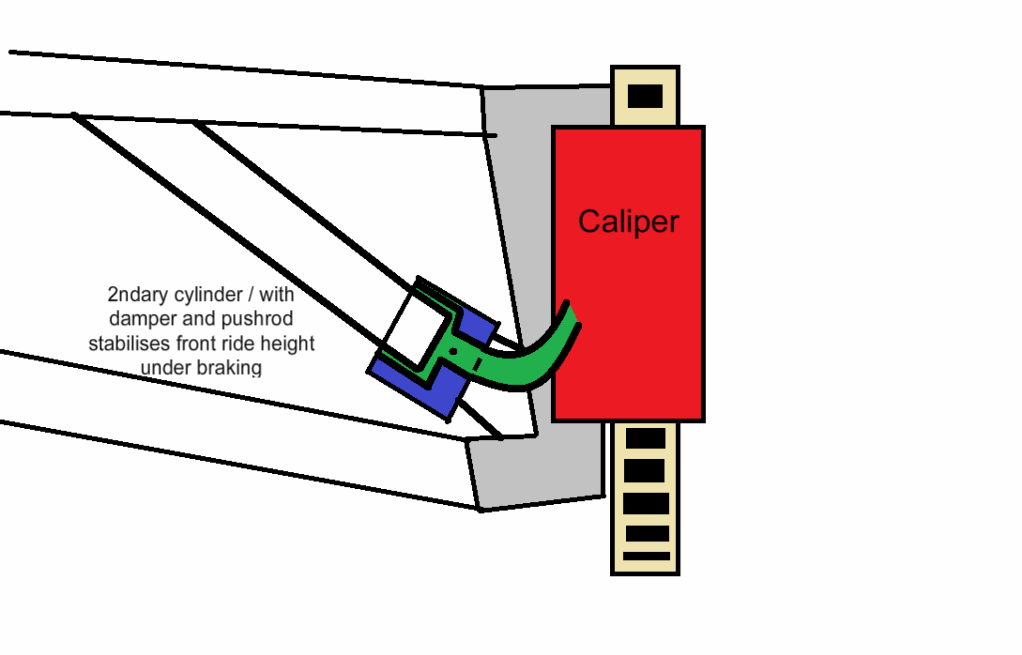- Login or Register
No account yet? Sign up
system can be used in reverse under acceleration, to reduce the amount of lift in the nose and keep the front wing aerodynamics optimised.

Yup; that's what we've been discussing for the last pageNonNewtonic wrote:Latest news from the factory: It was said that the R32 will feature a radical brake system which allow team to adjust the aerodynamic of the car by adjusting the ride height
WhiteBlue wrote:The way James Allan describes the system it could well be banned under §3.15 as a device that changes the aero config of the car. It will be interesting to lisen to the argument.

Because the carbon flextures are not as tough as metal I would think. Imagine jacking tons of force of dive into your flextures every lap. what do you think?Jersey Tom wrote:Curious why they wouldn't use geometric anti-dive to reduce loss of front ride height under the brakes.
Sounds like hydro dampers, but how actually works? I suspect that is not like hydrolink? Directly force inpud, but around brakes? maybe is that second piston in the brakes yaws some caint trigger and is connected with suspention arm piston?Instead it is reactive to brake torque and is linked directly to the suspension - so cannot be classified as a moveable aerodynamic device in the way that independent mass dampers were.


A moving caliper would be too risky IMO.. I think there is a simple hydraulic piston that reacts to pressure of the brake fluid inside the caliper. As the pressure increases the piston moves hydraulic fluid that is in a second circuit that is connected to another hydraulic cylinder in the upright.dren wrote:The caliper is linked directly to the suspension. It isn't fully ridged to the hub. The bolts probably ride in slots, allowing the caliper to move slightly. When you brake, the torque forces the caliper against the suspension system, opposing the car's tendency to dive when braking. This is what Renault is doing and what the Honda anti-dive system (TRAC) does.


It may not be the actual caliper moving, but the rotating energy in the rotor is being transfered into a force that opposes the dive under braking.n smikle wrote:A moving caliper would be too risky IMO.. I think there is a simple hydraulic piston that reacts to pressure of the brake fluid inside the caliper. As the pressure increases the piston moves hydraulic fluid that is in a second circuit that is connected to another hydraulic cylinder in the upright.dren wrote:The caliper is linked directly to the suspension. It isn't fully ridged to the hub. The bolts probably ride in slots, allowing the caliper to move slightly. When you brake, the torque forces the caliper against the suspension system, opposing the car's tendency to dive when braking. This is what Renault is doing and what the Honda anti-dive system (TRAC) does.
The unit likely has:
A check valve - to stop the car from braking while the suspension compresses.
A damper built in - to dampen vibrations.
A thermocouple activated valve? As the brakes come up to temperature the circuit is open.
Now fluid inerter make the sense! This systems are connected?dren wrote: It may not be the actual caliper moving, but the rotating energy in the rotor is being transfered into a force that opposes the dive under braking.
I think linking the hydraulic braking system in the way you have pictured would be illegal because simply by pressing the brake an opposing force would be given directly into the suspension link. That is completely driver controlled. The system I mentioned would work only when the car is moving, somewhat separated by driver input.
The Honda system used the rotating torque and transfered it into an opposing force for the anti dive they used on their motorcycles. I think the Renault system is similar.

Yes the honda system will work. (I did a small design similar to that in back in University to measure braking power).dren wrote:It may not be the actual caliper moving, but the rotating energy in the rotor is being transfered into a force that opposes the dive under braking.n smikle wrote:A moving caliper would be too risky IMO.. I think there is a simple hydraulic piston that reacts to pressure of the brake fluid inside the caliper. As the pressure increases the piston moves hydraulic fluid that is in a second circuit that is connected to another hydraulic cylinder in the upright.dren wrote:The caliper is linked directly to the suspension. It isn't fully ridged to the hub. The bolts probably ride in slots, allowing the caliper to move slightly. When you brake, the torque forces the caliper against the suspension system, opposing the car's tendency to dive when braking. This is what Renault is doing and what the Honda anti-dive system (TRAC) does.
The unit likely has:
A check valve - to stop the car from braking while the suspension compresses.
A damper built in - to dampen vibrations.
A thermocouple activated valve? As the brakes come up to temperature the circuit is open.
I think linking the hydraulic braking system in the way you have pictured would be illegal because simply by pressing the brake an opposing force would be given directly into the suspension link. That is completely driver controlled. The system I mentioned would work only when the car is moving, somewhat separated by driver input.
The Honda system used the rotating torque and transfered it into an opposing force for the anti dive they used on their motorcycles. I think the Renault system is similar.